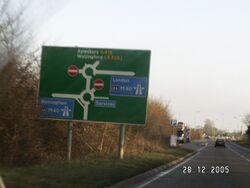Planning service area locations

Some of the most famous (and indeed infamous) motorway services in the country are positioned at difficult roundabouts. The blame for this varies depending on when they were built.
Until 1992, motorway service area locations were chosen by the government. There was no rule that they had to be built online, but they usually were. They were planned at intervals roughly every 15 miles (skipping every other service area on a quiet road). The precise location would be studied in detail, considering how much disturbance would be caused and how pleasant a site it would make.
As services became larger and motorways became less popular, planning services became more of an art. Motorways were opening around the rural-urban fringe where there were frequent junctions and plenty of irate neighbours. In addition, developers were falling out of love with the whole idea, so the government tried to keep them sweet by choosing profitable locations. These factors all combined to cause many motorways like the M25 and M42 to open without enough services, and to cause services to be proposed in totally unsuitable locations such as Gordano, South Mimms, Tamworth and Birchanger Green, which are all offline services. Like many Department for Transport bodge jobs, these junctions have gone on to cause a headache for Highways England.
By 1992, developers were totally responsible for planning service area locations. Developers favoured profitable locations at existing junctions, and the proposal was supposed to encourage more frequent, smaller services. A minimum distance of 15 miles was specified.
In 2013, the absolute minimum distance was abolished. Two rival service stations can in theory now be built opposite each other, if they can both get planning approval.
On A-roads, planning services has always been down to the private sector, with no joined-up planning process.
In Ireland, online services are planned by the state while offline services are planned by the private sector.